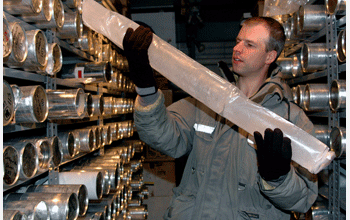Multimedia Gallery
Ultra-trace Elements Studies (Image 1)
Scientist Paolo Gabrielli examines an ice core in the cold storage facility at The Ohio State University's Byrd Polar Research Center.
More about this image
Scientist Paolo Gabrielli studies trace and ultra-trace elements -- miniscule amounts of metals carried to the ice primarily by dust -- in ice cores to learn about past environmental conditions and pollution.
Ice cores contain a wealth of information about past climate and environmental conditions, with clues in the form of trapped bubbles of gas and varying concentrations of chemical species and insoluble dust.
Ultra-trace elements are very, very small -- on the order of even less than one part per trillion. (In comparison, scientists talk about concentrations of atmospheric carbon dioxide in parts per million.) The trace elements are present in such a low amount that it is necessary to adopt exceptionally clean sample procedures and a special technique of mass spectrometry for their reliable detection called inductively coupled plasma sector field mass spectrometry.
"Trace elements can provide interesting information, such as evidence of past volcanic eruptions and the influx of extraterrestrial particles, but they also reveal the current anthropogenic contamination of the atmosphere," says Gabrielli.
Gabrielli is part of the ice core paleoclimatology team at The Ohio State University's Byrd Polar Research Center where he has established a new research program to study trace and ultra-trace metals in tropical and subtropical ice cores.
For additional information about Gabrielli's ultra-trace element research, see The Antarctic Sun story "Without a Trace." Or, to learn more about the Byrd Polar Research Center, visit their website. (Date of Image: April 2008) [See related image Here.]
Credit: Peter Rejcek, NSF
Images and other media in the National Science Foundation Multimedia Gallery are available for use in print and electronic material by NSF employees, members of the media, university staff, teachers and the general public. All media in the gallery are intended for personal, educational and nonprofit/non-commercial use only.
Images credited to the National Science Foundation, a federal agency, are in the public domain. The images were created by employees of the United States Government as part of their official duties or prepared by contractors as "works for hire" for NSF. You may freely use NSF-credited images and, at your discretion, credit NSF with a "Courtesy: National Science Foundation" notation.
Additional information about general usage can be found in Conditions.
Also Available:
Download the high-resolution JPG version of the image. (3.3 MB)
Use your mouse to right-click (Mac users may need to Ctrl-click) the link above and choose the option that will save the file or target to your computer.



